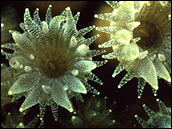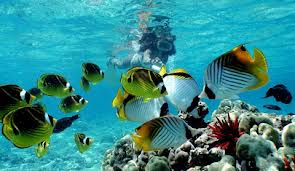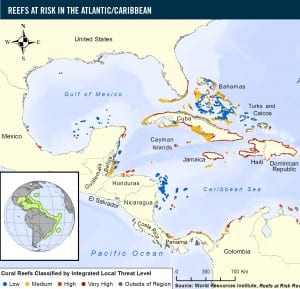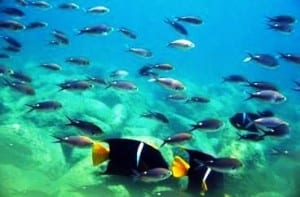Tripatini
the world's smartest travel social network
The World's "Undersea Rainforests" Need Protection
The mention of coral reefs usually brings to mind crystal-clear, warm tropical waters, bright colorful fish and coral … maybe even the movie, “Nemo.” Coral reefs form such vast, diverse ecosystems that they are commonly called the “rainforests of the oceans.”
Like the rainforests on land, coral reefs are extremely threatened by humans’ actions and climate change. Since the late 1970s, coral reefs across the world have been dying at an unprecedented rate, and it only seems to be getting worse, according to Phil Dustan, a marine biologist at the College of Charleston, South Carolina, in an Earth Observatory / NASA report.
“It’s a real tragedy,” states Dustan. “But over the past 20 years, we’ve seen a rapid decline in the vitality of coral reefs and their ecosystems worldwide.” In the report, Dustan explains that corals evolved in warm, clean, still waters with stable levels of sunlight and salinity. In order for the corals to survive, these waters must remain pristine and relatively undisturbed. A delicate balance also has to be maintained between the animals that feed on and live among the reefs. If any of these factors are thrown off balance, the polyps in the reef will be eaten away by predators, devastated by disease, or simply become so stressed that they die, Dustan explains.
 Corals are invertebrate animals that stay fixed in one place and live in tropical waters all over the world, usually close to the surface where the sun’s rays can reach them. Dustan explains that though corals may appear to be jagged stone plants sprouting from the ocean floor, only a very thin layer of polyps on the coral’s surface is actually alive. These polyps, which resemble tiny sea anemones, build interconnected tubes around themselves as protection against predators. Each time new polyps are born, they will construct their shells on top of their predecessors’. Stacks upon stacks of the limestone shells pile up on top of one another through the years to create coral branches and heads, and ultimately giant reefs (Miller and Crosby 1998).
Corals are invertebrate animals that stay fixed in one place and live in tropical waters all over the world, usually close to the surface where the sun’s rays can reach them. Dustan explains that though corals may appear to be jagged stone plants sprouting from the ocean floor, only a very thin layer of polyps on the coral’s surface is actually alive. These polyps, which resemble tiny sea anemones, build interconnected tubes around themselves as protection against predators. Each time new polyps are born, they will construct their shells on top of their predecessors’. Stacks upon stacks of the limestone shells pile up on top of one another through the years to create coral branches and heads, and ultimately giant reefs (Miller and Crosby 1998).
 Over millions of years, thousands upon thousands of species of sea creatures have come to depend on corals as a source of food and shelter. So far, researchers have identified nearly 4,000 kinds of fish and tens of thousands of invertebrates that thrive and depend on some 800 types of known coral, Dustan reports.
Over millions of years, thousands upon thousands of species of sea creatures have come to depend on corals as a source of food and shelter. So far, researchers have identified nearly 4,000 kinds of fish and tens of thousands of invertebrates that thrive and depend on some 800 types of known coral, Dustan reports.
Coral reefs are dying off due to pollution, overfishing, blast fishing (using dynamite to kill fish), and digging under the water. Coral reefs only develop in areas with specific environmental characteristics: Warm water temperatures, clear waters low in phosphate and nitrogen, a solid structure for attachment, and moderate wave action to disperse wastes and bring oxygen and plankton to the reef. Reef growth is extremely slow; an individual colony grows 1 to 7 inches (1 to 18 cm) in a year, depending on the species.
 A recent study by the Interamerican Association for Environmental Defense (AIDA), entitled “Coral Reefs in Costa Rica,” states that 97% of the 970 km2 of reefs that live in Costa Rica’s waters are threatened by human activities. Paradoxically, corals have a value of $582 million annually for Costa Rica, a product of its profits in fishing, tourism, scientific research, and in prevention of natural disasters (corals prevent coastal erosion caused by hurricanes and storms).
A recent study by the Interamerican Association for Environmental Defense (AIDA), entitled “Coral Reefs in Costa Rica,” states that 97% of the 970 km2 of reefs that live in Costa Rica’s waters are threatened by human activities. Paradoxically, corals have a value of $582 million annually for Costa Rica, a product of its profits in fishing, tourism, scientific research, and in prevention of natural disasters (corals prevent coastal erosion caused by hurricanes and storms).
The AIDA report calls for urgent action by Costa Rica’s government to protect coral reefs. While Costa Rica is bound by international treaties such as the United Nations Convention on the Law of the Sea to protect corals, the country does not have specific regulations that enforce these obligations.
Visit Costa Rica’s coral reefs
 Some of the best places to experience Costa Rica’s living coral reefs are Tortuga Island in the Nicoya Gulf (Pacific Ocean), Cano Island off the Osa Peninsula in the Southern Pacific, Uvita Island offshore of Limon and the Cahuita National Park – both on Costa Rica’s Caribbean Coast.
Some of the best places to experience Costa Rica’s living coral reefs are Tortuga Island in the Nicoya Gulf (Pacific Ocean), Cano Island off the Osa Peninsula in the Southern Pacific, Uvita Island offshore of Limon and the Cahuita National Park – both on Costa Rica’s Caribbean Coast.
The Cahuita National Park is home to one of Costa Rica’s largest coral reefs, and the only mature coral formation found along the Caribbean coast. Extending 500 meters out from Cahuita Point, the reef fans out over an area of about 600 acres (a square mile). Snorkeling in the area is fantastic, and you can swim right out from shore or go on a boat. You can see 35 species of coral and an abundant variety of marine life.
Enjoy an exciting 1-day snorkeling and hiking tour in the Cahuita National Park from Puerto Viejo with Costa Rica Special Deals. The Costa Rica travel agency offers top deals on Costa Rica vacation packages.
Learn more about what you can do to protect coral reefs at reef monitoring programs like the Global Coral Reef Monitoring Network and Reef Check. Both employ a network of volunteers around the globe to monitor reefs.
<iframe width="560" height="315" src="https://www.youtube.com/embed/cbN161yBBGA" frameborder="0" allowfullscreen></iframe>
Videos
Groups
-
India
173 members
-
Tour Operators
873 members
-
Ireland
93 members
-
South Dakota
17 members
-
Azerbaijan
17 members
-
Shopping the World
55 members
-
Tech for Travel/Hospital…
87 members
-
Andorra
26 members
-
Online Corner
75 members
-
Minnesota
22 members
-
Backpackers & Hostels
84 members
-
Portugal
60 members
-
Turks and Caicos
26 members
-
Agritourism/Farmstays
72 members
-
Zambia
21 members
© 2025 Created by EnLinea Media.
Powered by
![]()
Badges | Report an Issue | Privacy Policy | Terms of Service

You need to be a member of Tripatini to add comments!
Join Tripatini